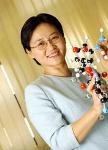Org. Synth. 2012, 89, 450-459
DOI: 10.15227/orgsyn.089.0450
Gold(I)-Catalyzed Decarboxylative Allylic Amination of Allylic N-Tosylcarbamates
Submitted by Dong Xing and Dan Yang
1.
Checked by Kin Yang and Viresh H.
Rawal.
1. Procedure
(E)-Pent-2-en-1-yl tosylcarbamate.
An oven-dried, 500-mL, 24/40-necked round-bottomed flask is equipped with a Teflon-coated oval magnetic stirring bar (35 × 15 mm) (Note 1).
The flask is connected to a solvent purification system, evacuated, charged with 200 mL of dichloromethane (DCM) (Note 2), refilled with nitrogen, and sealed with a rubber septum.
A needle inlet with a positive pressure of nitrogen is inserted into the septum.
(E)-2-Penten-1-ol (8.55 mL, 7.24 g, 84.0 mmol, 1.0 equiv) is added in one portion via syringe with stirring (Note 3).
The resulting clear solution is then cooled to approximately 0 °C by an ice-water bath for 20 min.
p-Toluenesulfonyl isocyanate (15.3 mL, 100.0 mmol, 1.2 equiv) is added dropwise over 15 min through the septum via syringe (Note 4).
Upon complete addition, the ice-bath is removed and the reaction is allowed to warm to room temperature (23 °C).
After 30 min, TLC analysis shows complete consumption of the starting material (Note 5).
The reaction mixture is transferred to a 1-L separating funnel and washed with 400 mL of saturated aqueous NH4Cl (Note 6).
After the layers are separated, the aqueous phase is extracted with DCM (2 × 200 mL).
The combined organic phase is stored in a 1-L Erlenmeyer flask and dried with 30 g of Na2SO4 for 30 min (Note 7).
The solution is then filtered through a cotton plug into a 1-L recovery flask and concentrated on a rotary evaporator (20 mmHg, 25 °C) to give the crude product as a colorless oil.
The crude oil is dissolved in ~15 mL of DCM and loaded onto a chromatography column (5 × 17 cm, 120 g silica) (Note 8).
After loading, the column is flushed with 400 mL of hexanes.
Fraction collecting is started as 1 L of Hex:EtOAc:DCM (100:20:5) is added (flow rate: 20 mL/min, 25 mL fractions) (Note 9 and 10).
Fractions containing the pure product (fractions 38-61) are combined and concentrated to yield 22.85-23.24 g (96-97%) of (E)-pent-2-en-1-yl tosylcarbamate as a viscous colorless oil (Note 11).
N-(1-Ethyl-2-propen-1-yl)-4-methyl-benzenesulfonamide.
A 500-mL, 29/32 necked round-bottomed flask equipped with a Teflon-coated oval magnetic stirring bar (50 × 20 mm) is charged with a solution of (E)-pent-2-en-1-yl tosylcarbamate (3.66 g, 12.9 mmol, 1.0 equiv)
in 66 mL of 1,2-dichloroethane (DCE) (Notes (Note 12)(Note 13)(Note 14)-(Note 15)).
Diisopropylethylamine (Hünig's base) (2.25 mL, 1.60 g, 12.9 mmol, 1.0 equiv) is then added and the clear solution is allowed to stir for 5 min.
Water (66 mL) is added with vigorous stirring, resulting in a biphasic, milky solution (Notes 16 and 17).
After stirring for 5 min, gold (I) chloride (AuCl) (150 mg, 0.645 mmol, 0.05 equiv) is added in portions over one minute (Note 18).
Upon the addition of AuCl, the milky solution acquires a yellow tint (Note 19).
Silver (I) triflate (AgOTf) (166 mg, 0.645 mmol, 0.05 equiv) is then added in one portion resulting in a much whiter solution (Note 20).
A reflux condenser (30 × 3 cm) with a steady cold water flow is affixed, and the flask is then placed into a pre-heated oil bath (85 °C, bath temp.).
The apparatus is then covered up with aluminum foil to minimize the exposure to light.
After 1 h, the reaction progressively becomes clearer until the white color dissipates to leave a transparent/grayish solution with some black precipitate.
Monitoring by 1H NMR shows the reaction to be nearly complete at 3 h (Note 21).
After cooling to room temperature, the reaction mixture is diluted with 75 mL of DCM, and 75 mL of brine.
The organic layer is separated and the aqueous layer is extracted with DCM (2 × 75 mL).
The combined organic phase is dried with 10 g of Na2SO4 over 30 min, then concentrated on a rotary evaporator (20 mmHg, 25 °C) to yield the crude product as a grayish/transparent oil.
The oil is dissolved in ~5 mL DCM, loaded onto a chromatography column (17 × 5 cm, 80 g silica), and flushed with 200 mL of hexanes.
Fractions were collected as the column is eluted with 1 L of 100:15:5 mixture of Hex:EtOAc:DCM (flow rate: 20 mL/min, 25 mL/fraction).
The product is found in fractions 12-30 (Note 22), which are combined and concentrated to afford 2.57 g (83% yield) of N-(1-ethyl-2-propen-1-yl)-4-methyl-benzenesulfonamide as a colorless oil that solidified upon storing neat in the refrigerator (Note 23).
2. Notes
1.
The flask was dried overnight in a 120 °C oven prior to use and cooled under vacuum.
2.
Dichloromethane (Optima Grade) was purchased from Fisher Scientific and dried by an Innovative Technologies solvent purification system.
3.
(E)-2-Penten-1-ol (95%) was purchased from Aldrich Chemical Company and used as received.
The NMR spectrum of the Aldrich sample showed the presence of ~10% 1-pentanol, which reacts in Step A to give the corresponding saturated carbamate.
The quantities used and the yields obtained are not corrected for the presence of this impurity.
4.
p-Toluenesulfonyl isocyanate (96%) was purchased from Aldrich Chemical Company and used as received.
5.
(E)-2-Penten-1-ol is not observable under UV (254 nm), but the product of step A is observable.
Both of these compounds are separated using 1:3 EtOAc:Hexanes on Whatman brand silica plates (250 μm), and visualized using KMnO
4: R
f 0.34 (starting material); R
f 0.28 (product).
6.
Ammonium chloride (NH
4Cl) (A.R.
grade) was purchased from Fisher Scientific.
7.
Sodium sulfate (Na
2SO
4), anhydrous (A.R.
grade), was purchased from Fisher Scientific.
8.
Silica gel P60 (230-400 mesh) was purchased from Silicycle.
9.
Hexanes (HPLC grade) was purchased from Fischer Scientific.
10.
Ethyl acetate (G.R.
grade) was purchased from Fischer Scientific.
11.
The product contains ca.
10% of the saturated carbamate, which arises from the saturated alcohol impurity in the starting material (see Note 3).
The product exhibited the following characterization data:
1H NMR
pdf(500 MHz, CDCl
3) δ: 0.96 (t,
J = 7.5 Hz, 3 H), 2.04 (p,
J = 6.5 Hz, 2 H), 2.44 (s, 3 H), 4.51 (dd
, J = 7.0, 1.5 Hz, 2 H), 5.45 (dtt,
J =15.5, 6.5, 1.5 Hz, 1 H), 5.77 (dtt,
J = 15.5, 6.0, 1.0 Hz, 1 H), 7.36 (d
, J = 8.5 Hz, 2 H), 7.80 (bs, 1 H), 7.93 (d
, J = 8.0 Hz, 2 H);
13C NMR
pdf(100 MHz, CDCl
3) δ: 13.1, 21.8, 25.3, 67.8, 121.7, 128.6, 129.7, 135.8, 139.5, 145.2, 150.7; IR (CH
2Cl
2): 3369, 1753, 1599 cm
−1; HRMS (ES+)
m/z calcd for C
13H
17NO
4S (M + Na): 306.0771, Found: 306.0768.
Anal.
Calcd.
for C
13H
17NO
4S: C, 55.11; H, 6.05; N, 4.94.
Found: C, 55.17; H, 6.08 N, 5.00.
12.
It is important to use a large stir bar to promote efficient stirring of the heterogeneous reaction mixture.
13.
The viscous carbamate was dissolved in DCM, transferred to a tared reaction flask, then concentrated down to get the mass before dissolving in DCE for use in the reaction.
As the starting material is contaminated with 10% of the saturated carbamate, only 90% (3.294 g) is able to react in this step.
14.
1,2-Dichloroethane (anhydrous, 99.8%) was purchased from Aldrich Chemical Company.
15.
The submitters used 1:9 DCE:H
2O solvent system, which achieved conversions of about 80%.
The checkers found the reaction to go to near complete conversion in 1:1 DCE:H
2O.
16.
Water (HPLC grade) was purchased from Aldrich Chemical Company.
17.
The submitters added Hünig's base after the addition of water.
N,N-Diisopropylethylamine (ReagentPlus, 99%) was purchased from Sigma-Aldrich Chemical Company and used as received.
18.
Gold (I) chloride (99.9%+) was purchased from Aldrich Chemical Company and used as received.
19.
A small amount of black solid is observed in the milky solution.
At this point, the lights are also turned off as a precaution.
20.
Silver (I) trifluoromethanesulfonate (99%) was purchased from Strem Chemical Company and used as received.
21.
After 3 h, a small aliquot of the reaction mixture is taken (~0.2 mL) by syringe, extracted with DCM (1 mL), dried (Na
2SO
4), and concentrated to afford the NMR sample.
The spectra reveal the reaction to have gone to ~95% conversion.
Conversion is determined by the ratio of one of the internal alkene protons (5.77 or 5.45 ppm) of the starting material to the internal vinyl proton (5.54 ppm) of the product.
Prolonged heating (> 10 h) does not increase conversion to the product and causes the formation of an unidentified side-product.
22.
The product has an R
f = 0.23 in 100:15:5 Hex:EtOAc:DCM and is stained by KMnO
4.
23.
The yield listed is uncorrected for the presence of 10% of the saturated alcohol starting material.
When corrected for starting material purity (90%), the isolated yield for step B is 92.5%, close to the actual conversion.
For the second run on a 3.2 g (11.3 mmol) scale, the yield was 81% (2.19 g, uncorrected), or 90% if corrected for starting material purity.
The submitters reported an isolated yield of 76%.
The product exhibited the following characterization data: mp 32-34 °C;
1H NMR
pdf(500 MHz, CDCl
3) δ: 0.82 (t
, J = 7.5 Hz, 3 H), 1.50 (p,
J = 7.0 Hz, 2 H), 2.42 (s, 3 H), 3.65-3.71 (m, 1 H), 4.77 (d,
J = 8.0 Hz, 1 H), 4.95-5.01 (m, 2 H), 5.54 (ddd
, J = 17.0, 10.5, 6.5 Hz, 1 H), 7.28 (d
, J = 8.0 Hz, 2 H), 7.75 (d
, J = 8.0 Hz, 2 H);
13C NMR
pdf(100 MHz, CDCl
3) δ: 9.9, 21.7, 28.6, 57.9, 116.1, 127.3, 129.6, 137.7, 138.3, 143.3; IR (CH
2Cl
2): 3280, 1602, 1435 cm
−1; HRMS (ES+)
m/z calcd for C
12H
17NO
2SNa (M
+ + Na): 262.0872 Found: 262.0870.
Anal.
Calcd.
for C
12H
17NO
2S: C, 60.22; H, 7.16 ; N, 5.85.
Found: C, 60.17; H, 7.11; N, 5.92.
Handling and Disposal of Hazardous Chemicals
The procedures in this article are intended for use only by persons with prior training in experimental organic chemistry. All hazardous materials should be handled using the standard procedures for work with chemicals described in references such as "Prudent Practices in the Laboratory" (The National Academies Press, Washington, D.C., 2011 www.nap.edu). All chemical waste should be disposed of in accordance with local regulations. For general guidelines for the management of chemical waste, see Chapter 8 of Prudent Practices.
These procedures must be conducted at one's own risk. Organic Syntheses, Inc., its Editors, and its Board of Directors do not warrant or guarantee the safety of individuals using these procedures and hereby disclaim any liability for any injuries or damages claimed to have resulted from or related in any way to the procedures herein.
3. Discussion
Allylic amines are important and versatile synthetic intermediates in organic chemistry.
Preparation of allylic amines from cheap and readily available allylic alcohols is the most powerful and convenient protocol in organic synthesis.
2 Allylic carbamates, which are easily prepared from allylic alcohols and isocyanates, have been widely applied to the low valent transition metal catalyzed allylic substitution reactions for the preparation of allylic amines.
3 In these reactions, ancillary ligands are always required in order to control the regio- and stereoselectivities.
With the acidic NH group, allylic carbamates could be easily converted into its imidate form in the presence of a suitable base.
Therefore, it is also a good candidate to undergo an aza-Claisen rearrangement.
4,5The procedures described above offer an efficient and mild gold(I)-catalyzed method for the preparation of
N-tosyl allylic amines.
6 We chose allylic
N-tosylcarbamates as substrates since they are highly acidic and could be easily deprotonated into imidates with simple bases.
As a result of the base-induced aza-Claisen rearrangement pathway, excellent regioselectivites and high to excellent stereoselectivities can be achieved with no additional need for ancillary ligands.
With this method, a series of C1 or C3-substituted and C3-disubstituted
N-tosyl allylic amines can be prepared in short reaction times with moderate to excellent yields (Table 1).
In addition, this reaction can be conducted by using water as the solvent, representing an environmentally benign and easily-handled protocol.
However for large-scale preparation, the collection of AuCl with the large amount of insoluble and sticky carbamate substrate in water deactivated the catalytic ability of AuCl and therefore caused low conversion.
To overcome this drawback, we applied a two-phase solvent system using water and 1,2-dichloroethane (DCE) in a 9:1 volume ratio for large scale synthesis.
Under such reaction condition, the product could be afforded in about 80% conversion.
On the other hand, the checkers found that the use of a 1:1 DCE:H
2O solvent system could provide the product in near complete conversion.
Since this transformation undergoes a concerted aza-Claisen rearrangement pathway, enantiopure
N-tosyl allylic amines can be prepared from chiral allylic alcohols through chirality transfer (Table 1, entry 12).
This transformation could be performed in one pot starting directly from allylic alcohols.
This one-pot protocol was initially developed to overcome the unwanted [3,3]-oxo-rearrangement during the efforts to prepare C3-alkenyl substituted allylic
N-tosylcarbamate (Scheme 1).
By adding
N,N-diisopropylethylamine (DIPEA) to the 1,2-dichloroethane (DCE) solution of allylic alcohols prior to the addition of tosyl isocyanates, the [3,3]-oxo-rearrangement can be inhibited since the C3-alkenyl substituted allylic
N-tosylcarbamate has been converted to its imidate form in situ.
AuCl and AgOTf were then directly added to the above mixture.
After a short reaction time at 75 °C, a variety of synthetically important
N-tosyl dienylamines, as well as C3-disubstituted
N-tosyl allylic amines, could be afforded with moderate yields and good to excellent stereoselectivities (Table 2).
7Scheme 1. Unexpected [3,3]-Oxo-Rearrangement
Table 1. Gold(I)-Catalyzed Decarboxylative Amination of N-Tosylcarbamates in Water a
Table 2. Products Obtained via One-Pot Synthesis a, b, c
Appendix
Chemical Abstracts Nomenclature (Collective Index Number);
(Registry Number)
trans-2-Penten-1-ol: 2-penten-1-ol, (2E)-; (1576-96-1)
p-Toluenesulfonyl isocyanate; (4083-64-1)
N,N-Diisopropyl ethylamine; (7087-68-5)
Gold(I) chloride; (10294-29-8)
Silver trifluoromethanesulfonate: Methanesulfonic acid, trifluoro-, silver(1+) salt; (
2923-28-6)
 |
Dan Yang was born in Sichuan, China.
She received her BSc in Chemistry from Fudan University, P.
R.
China, in 1985.
Through the US-China Chemistry Graduate Program, she obtained an MA in 1988 at Columbia with Professor Ronald Breslow and a PhD from Princeton under the guidance of Professor Daniel Kahne in 1991.
She then spent two years as a postdoctoral fellow with Professor Stuart Schreiber at Harvard.
In 1993, she joined The University of Hong Kong, where she is currently the Morningside Professor in chemical biology.
Her research interests include asymmetric catalysis and total synthesis, the design and synthesis of novel foldamers and the chemical biology of natural products. |
 |
Dong Xing was born in Henan, China, in 1982.
He received his BSc in Chemistry and his MSc in Organic Chemistry with Prof.
Liping Yang and Prof.
Zhangjie Shi (Peking University) at East China Normal University in 2003 and 2006 respectively.
He obtained his PhD under the supervision of Professor Dan Yang at the University of Hong Kong in 2011.
His research interests include tandem cyclization reactions and their application to total synthesis of natural products. |
 |
Kin Yang was born in 1988 in Guangdong, China.
Two years later, he immigrated to the United States and settled in New York City.
In 2010, he went on to obtain a B.S.
degree in chemistry from Syracuse University where he worked with Prof.
Don Dittmer on applications of tellurium in organic chemistry.
In the same year, he enrolled in a Ph.D.
program at the University of Chicago.
He is currently working in the area of hydrogen-bonding catalysis under the supervision of Prof.
Viresh Rawal.
|
Copyright © 1921-, Organic Syntheses, Inc. All Rights Reserved